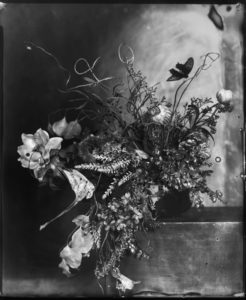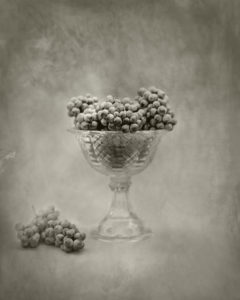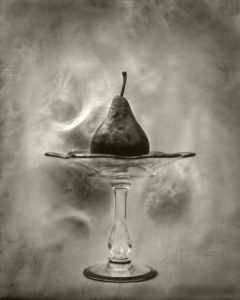Ottawa photo-artist Christine Fitzgerald is heading to the Canadian embassy in Washington. You might say her posting will be long.
Fitzgerald has not become a diplomat. Instead, two of her painterly photographs created by the 19th century wet collodion process are headed to the embassy for an exhibition involving 27 Canadian women artists.
Her photographs, and the works of all the other artists, will remain for an indefinite time at the embassy, moving from the building’s art gallery after the exhibition to be placed in less public areas, says Denis Chouinard, counsellor, public affairs.
Fitzgerald is thrilled at the selection of her work and definitely plans to attend the exhibition opening.
“How did I feel about being in this exhibition?” Fitzgerald asked rhetorically. “One word — honoured! When I received the news by email I re-read the email a few times just to make sure I was reading it correctly. I was incredibly moved to have my work represented alongside the artwork of other Canadian women artists. I love the title for the exhibition, New Light. My medium is all about light.”

Meryl McMaster’s Jin is included. Courtesy the artist
Fitzgerald is one of three Ottawa artists with works in A New Light: Canadian Women Artists. The show is at the embassy on prestigious Pennsylvania Avenue from Feb. 7 to April 30.
The other two Ottawans are also photo-based artists. One is Meryl McMaster (“I think it is a great opportunity”) who will be represented by a ghostly white self-portrait called Jin. The other Ottawa artist is Whitney Lewis-Smith, who is exhibiting one of her trademark black-and-white photographs of stunning still life bouquets; this one is called The Impossible. “It’s such a pleasure to see how they move the work around and curate the collection,” says Lewis-Smith.
Works in the exhibition are all from three important collections that regularly loan works to the embassy: The Canada Council Art Bank, the Global Affairs Department and Scotiabank. Embassy officials had “a conversation” for about a year with each organization deciding which works to select, says Chouinard.
It was decided to do a women-only exhibition because male artists far outnumbered female ones among the 185 works at the embassy on a long-term basis. Installing all 38 works from the 27 women artists around at the embassy after the exhibition will help create a better gender balance. The exhibition title was inspired by the “light” that seemed to emanate from some of the abstract paintings selected.

The Impossible. Whitney Lewis-Smith. Courtesy the artist.
“These new works are part of a broader commitment to incorporate works which illuminate Canada’s diversity, both with regards to genres of media and their artists’ backgrounds,” says Michelle Mahoney, an embassy media relations officer.
Scotiabank explained its selection process this way: “The criteria for the artwork selected was to feature exceptional Canadian women artists from the Scotiabank Fine Art Collection. We’ve made an effort to represent both emerging and established artists who work in a variety of mediums — printmaking, photography, painting.”
Scotiabank contributed work from eight artists, including a mixed media image, titled The Spirit of the Owl, by Alberta Indigenous artist Jane Ash Poitras. The Canada Council loaned six artworks, including McMaster’s self-portrait and an abstract painting, Strawberry Dreams, Strawberry Nightmares by Milly Ristvedt of Tamworth, near Kingston. The rest of the works, including the Fitzgerald and Lewis-Smith photographs, are from Global Affairs.
The Canada Council’s participation in the exhibition is in line with the agency’s attempts to see more Canadian art and artists abroad in the name of cultural diplomacy.
Simon Brault, head of the council, said in a recent ARTSFILE interview that Canada can’t advance any of its economic or geopolitical objectives without good diplomacy and “one of the weakest parts of our public diplomacy” is cultural diplomacy.
That was particularly weak during the Stephen Harper era but the Justin Trudeau administration is more open, Brault says. Mandate letters from the prime minister to the ministers of Global Affairs and Heritage emphasized the need for more initiatives in cultural diplomacy.

Risa Horowitz’s Tsuga Canadensis (commonly known as the Eastern Hemlock). Courtesy the artist.
The artists in the Washington exhibition are a diverse list in terms of media and geography. They include the late Joyce Wieland, one of the 20th century’s most celebrated female artists; Dorothy Knowles, a veteran Saskatchewan painter of traditional prairie landscapes; Ningiukulu Teevee, a Nunavut graphic artist; Mary Yuusipik Singaqti, an Inuit sculptor; Dianne de Corby, a Manitoba quilter; Amalie Atkins, a Saskatoon photo-artist; and Risa Horowitz, a multi-media artist from Regina.
Five stylized tree paintings by Horowitz will be in the exhibition, on loan from the Scotiabank collection.
“The embassy tells me that these will be on long-term loan, being moved to the chancery after the public exhibition as part of the revised art plan for their entire collection,” says Horowitz.
Saskatoon artist Amalie Atkins is represented in the exhibition with a haunting photograph titled Ukrainian Dancers Huddle, showing a group of costumed Ukrainian dancers from the group Pavlychenko Folklorique Ensemble closely grouped together like a football huddle on a barren mound of earth. The photo has already been at the embassy for a year.

Christine Fitzgerald. Champagne Grapes. Courtesy the artist.
“I was just thinking about this show and feeling excited to have my photo Huddle in the Embassy show,” Atkins wrote in an email. “The work is about gathering and holding collective female strength in the midst of grief and turmoil. The photo was taken years earlier but if feels current and universal.”
The journey to the embassy in Washington by Ottawa’s Fitzgerald is just the latest triumph for the former federal bureaucrat, who did not start taking pictures in earnest until 2012 when her husband gave her a camera for Christmas. She quickly became obsessed. Fitzgerald took courses at the School of the Photographic Arts: Ottawa and then embarked on a successful career that has included publication of work in National Geographic. Most recently in Ottawa, she had a highly rated exhibition of photographs of parrots at Studio 66.
The two photographs by Ottawa’s Fitzgerald in the Washington show are titled Champagne Grapes and Williams Pear.

Christine Fitzgerald. Williams Pear. Courtesy the artist.
“The pieces are fruit studies that are part of a series titled, Diversity, that celebrates the diversity of fruits and vegetables available today,” says Fitzgerald. “My motivation in creating the series was to experiment with forms, compositions and colours. I used the 19th century wet collodion photographic process which requires day light. The chemistry cannot ‘read’ all the colours of the light spectrum — reds, oranges and yellows are developed as different tones of black. I also experimented with light — the absolute best light for this process is 11:30 a.m. outdoor on a clear day. My best studio is outside.”






